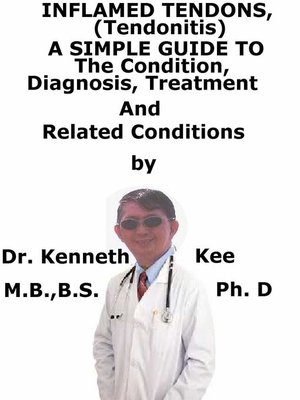Inflamed Tendons (Tendonitis) a Simple Guide to the Condition, Diagnosis, Treatment and Related Conditions
ebook
By Kenneth Kee

Sign up to save your library
With an OverDrive account, you can save your favorite libraries for at-a-glance information about availability. Find out more about OverDrive accounts.
Find this title in Libby, the library reading app by OverDrive.



Search for a digital library with this title
Title found at these libraries:
| Library Name | Distance |
|---|---|
| Loading... |
Tendonitis is the inflammation and swelling of the enclosed or sheathed tendons.Tendons are the strong fibrous structures that attach muscles to bones.When these tendons become swollen or inflamed, it is termed tendonitis.In many patients, tendinosis (tendon degeneration) is also present.It can happen together with synovitis (inflammation of the tendons sheaths or synovium).It can also produce stenosing tendonitis (tightened inflammation of the tendon sheaths).Causes:The most frequent cause is excess use of the involved tendon.These disorders are more frequent in middle-aged adults and mostly in people who are play sports.They may be more frequent if the work requires repetitive movements such as writing, typing or use of a computer mouse.Some risk factors are:1. Injury or damage to the tendon2. Repetitive movements of finger and wrist joints3. Arthritis of the joints may be prone to tendonitis4. Systemic disorders such as multiple sclerosis, amyloidosis, rheumatoid arthritis5. Tendonitis happens in families, and is normally appear more often in males than in females6. Tendonitis can happen as a result of injury or excess use.7. Playing sports is a frequent cause.8. Tendonitis also can happen with aging as the tendon's elasticity becomes loosen.Body-wide (systemic) diseases, such as rheumatoid arthritis or diabetes, can also result in tendonitisThe main symptoms are pain, tenderness and occasionally swelling of the affected part of the tendon.1. Pain on movement of the tendona. Pain and tenderness along a tendon, normally near a jointb. Pain at nightc. Pain that becomes worse with movement or action2. Swelling of part of the tendon affected3. Stenosis of the tendon sheath may be present4. Stiffness in the morning5. Stiffness of the tendon - inability to stretchSigns:1. Swelling over the affected tendon2. Passive stretching of the tendon is painful.3. There may be local tenderness of the inflamed tendon.4. The tendons sheaths are normally swollen and thickened5. The tendons may become stuck in the narrowed tendon sheaths (Trigger Finger)6. There may be crepitations over the tendon as it travels across the sheathsThere are definite tests for specific tendons.The tendon may be inflamed, and the skin over it may be warm and red.If an infection is the suspected cause (rare) then blood tests and other tests may be performed to find the cause of the infection.Occasionally, if the diagnosis is not certain, the doctor may suggest:1. Ultrasound scan2. X-ray3. MRITreatment may be conservative:1. Rest of the tendon2. Splints or brace3. Cold or ice4. Pain killers such as NSAID5. Muscle relaxant6. PhysiotherapyA physiotherapist will give the patient a program of exercises to slowly make the muscles of the involved tendon stronger.This will require doing exercises that raise the load that the muscle can carry.7. Injection of local anesthetic and long acting steroid into the affected sheath or tendon nodule may help to reduce inflammationSurgery Treatment:Surgical opening of the synovial sheath may be necessary for tendon release.In rare cases, surgery is needed to remove the inflamed tissue from around the tendon.Other treatments are also being given to treat tendonitis:1. Shock-wave therapy2. Autologous blood injectionBlood is taken from the patient and then injected into the region around the injured tendons.TABLE OF CONTENTIntroductionChapter 1 Inflamed Tendons (Tendonitis)Chapter 2 CausesChapter 3 SymptomsChapter 4 DiagnosisChapter 5 TreatmentChapter 6 PrognosisChapter 7 Trigger FingerChapter 8 De Quarvian's DiseaseEpilogue







